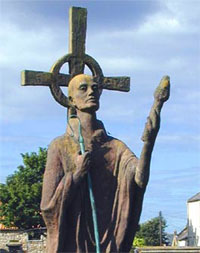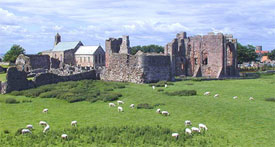Readings:
Proverbs 3:21-32
Psalm 103:13-18
1 Corinthians 9:16-23
Matthew 19:27-30Preface of Apostles and Ordinations
[Common of a Pastor]
[Common of a Monastic or Professed Religious]
[For the Ministry II]
[Of the Reign of Christ]
PRAYER (traditional language)
O loving God, who didst call thy servant Aidan from the
cloister to re-establish the Christian mission in northern
England: Grant, we beseech thee, that we, following his
example, may use what thou hast given us for the relief of
human need, and may persevere in commending the saving
Gospel of our Redeemer Jesus Christ; who liveth and
reigneth with thee and the Holy Ghost, one God, for ever
and ever. Amen.
PRAYER (contemporary language)
O loving God, you called your servant Aidan from the cloister to re-establish the Christian mission in northern England: Grant that we, following his example, may use what you have given us for the relief of human need, and may persevere in commending the saving Gospel of our Redeemer Jesus Christ; who lives and reigns with you and the Holy Spirit, one God, for ever and ever. Amen.
Lessons revised a General Cponvention 2024
Return to Lectionary Home Page
Webmaster: Charles Wohlers
Last updated: 10 July 2024
AIDAN
MISSIONARY, ABBOT, BISHOP OF LINDISFARNE (31 AUGUST 651)
The Gospel first came to the northern English in 627, When King Edwin of Northumbria was converted by a mission from Canterbury led by Bishop Paulinus, who established his see at York. Edwin's death in battle in 632 was followed by a severe pagan reaction. A year later, Edwin's exiled nephew Oswald gained the kingdom, and proceeded at once to restore the Christian mission.
 During
his exile, Oswald had lived at Columba's monastery of Iona (see 9 June),
where he had been converted and baptized. Hence he sent to Iona, rather
than to Canterbury, for missionaries. The first monk to preach was a man
named Corman, who had no success, and returned to Iona to complain that
the Northumbrians were a savage and unteachable race. A young monk
named Aidan responded, "Perhaps you were too harsh with them, and they
might have responded better to a gentler approach." At this, Aidan found
himself appointed to lead a second expedition to Northumbria. He centered
his work, not at York, but in imitation of his home monastery, on Lindisfarne,
an island off the northeast coast of England, now often called Holy Isle.
With his fellow monks and the English youths whom he trained, Aidan restored
Christianity in Northumbria, King Oswald often serving as his interpreter,
and extended the mission through the midlands as far south as London.
During
his exile, Oswald had lived at Columba's monastery of Iona (see 9 June),
where he had been converted and baptized. Hence he sent to Iona, rather
than to Canterbury, for missionaries. The first monk to preach was a man
named Corman, who had no success, and returned to Iona to complain that
the Northumbrians were a savage and unteachable race. A young monk
named Aidan responded, "Perhaps you were too harsh with them, and they
might have responded better to a gentler approach." At this, Aidan found
himself appointed to lead a second expedition to Northumbria. He centered
his work, not at York, but in imitation of his home monastery, on Lindisfarne,
an island off the northeast coast of England, now often called Holy Isle.
With his fellow monks and the English youths whom he trained, Aidan restored
Christianity in Northumbria, King Oswald often serving as his interpreter,
and extended the mission through the midlands as far south as London.
 |
Ruins
of the medieval monastery at Lindisfarne [photo by author] |
Aidan died at the royal town of Bamburgh, 31 August,
651. The historian Bede said of him: "He neither sought nor loved anything
of this world, but delighted in distributing immediately to the poor whatever
was given him by kings or rich men of the world. He traversed both town
and country on foot, never on horseback, unless compelled by some urgent
necessity. Wherever on his way he saw any, either rich or poor, he invited
them, if pagans, to embrace the mystery of the faith; or if they were
believers, he sought to strengthen them in their faith and stir them up
by words and actions to alms and good works."